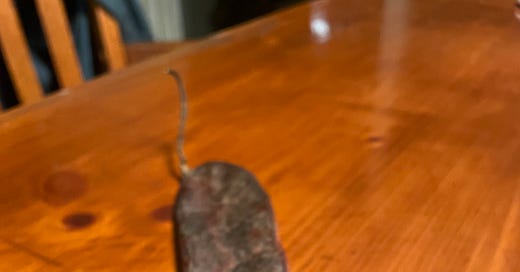I’ve got a pair of really nice dogs. Both came secondhand from families who didn't want them anymore, and both have turned out to be wonderful friends who are perpetually happy to go along with any and all family activities. The dog we’ve had the longest is an Australian shepherd, medium-sized, smart, antsy, and fast. Her new friend is a 100 pound lab who’s sweet, clumsy, and curious. They’ve only known each other since July, but they’ve fallen into a shared rhythm of exploration and rest, each taking turns initiating play.
These two nice dogs have a pattern they tend to follow. The smaller, swifter one takes off after something she sees or hears in the woods, and her big companion goes lolloping after her. The shepherd comes back when the chipmunks duck into their holes or the deer bound back through the thicket, but the lab hangs around, taking his time making his way back to the house.
This lab is quite firmly an omnivore, much unlike his picky pal. We often find that when he comes back from the woods, he’s brought a little snack with him. He eats such a wide variety of things that I think if he ever went on a Homeward Bound-type journey, he could get by fairly well, food-wise. He loves to munch on hickory nuts, which he can crack on his own, and he scrounges up acorns of all kinds. This dog will race you to the persimmon trees and suck up every fruit he can find lying on the ground. You have to be quick to beat him to a wild snack.
A couple of days ago, after the dogs took off for a little excitement in the woods, they shortly emerged, covered in stick tights. The lab was packing a pretty big prize. It was a large tree pod of some kind, about 10 inches long and an inch and a half wide, fairly flat, colored the deep brown of something that had rested for quite a while against the forest floor, and wonderfully fragrant. I could see why this funny forager had brought it up out of the woods, but I wasn’t sure what it was right away, so I took it from him. He went right back to the tree line and came back with two more.
Now I had three of these pods in my hands, and they were each seeping a thick, sticky goo that smelled sweet and nutty, the scent something like a mix of honey and white walnuts. I walked to the edge of the woods with the pods in my hands, looking at the closest trees to see if the pods belonged to them. For a moment, I tried to remember exactly what the pods of catalpa and Kentucky coffee trees looked like, thinking these could be the most likely candidates.
A quick internet search let me know that my first two guesses were incorrect, so I called my mom, who always seems to have the answers to my questions about growing things. I described the pod and she knew what it belonged to right away: a honey locust.
For some, these trees are pesky. They have large, sharp thorns, they sprout up faster than fast, and their blooms trigger seasonal allergies in a lot of people. I love them, despite these things. I used to be allergic to locust trees, but thankfully I’m not anymore. Honey locust blooms produce one of my very favorite smells, and even when I knew I’d pay for it with relentless congestion, I would run out to find a low branch of locust flowers on the day they bloomed each spring, inhaling all the sweet scent my nostrils could hold.
We moved to our new home after the spring bloom had passed, and we haven’t been through every bit of the woods yet, so we still don’t know what all types of trees are in our care. Because my husband is a beekeeper, discovering that these honey locusts are so close to where the hives are kept is fantastic. The bees love the plentiful locust blooms that help them to make a delicious, distinct honey.
I look forward to the honey locust’s spring flowering, but I don’t want to wish the next two seasons away. This coming week will be balmy, by October’s standards, with warm sunshine and cool breezes. I think I’ll follow the dogs into the woods to find exactly where the locusts live, and maybe try to solve another little forest mystery.




